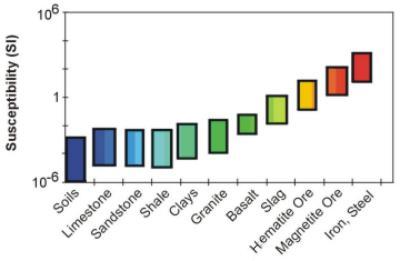Environmental Geophysics
Geomagnetic Field
The geomagnetic field of the earth is very similar to that of a large bar magnet placed at the center of the Earth, with its south end oriented toward the north magnetic pole. The field is dipolar, vertically downward at the north magnetic pole, vertically upward at the south magnetic pole, and horizontal at the (magnetic) equator. It has a strength of roughly 30,000 gammas at the equator, 70,000 gammas at the poles. In the United States, it is acceptable for the purposes of simple modeling to assume that a field declination of about 60 degrees has a strength of 55,000 gammas. Figure 1 illustrates the magnetic field arround the earth as well as the difference in geographic loaction between the magnetic north pole and geographic north poles. Figure 2 shows the variation in total magnetic field for the earth, while figure 3 shows a close up of North America. These maps can be useful for determining the relative total magnetic intensity prior to begining a field survey.

Figure 1. Illustration of the orientation of magnetic field lines around planet earth (http://anshsmagnetism.wordpress.com/basic-concepts/).

Figure 2. Total magnetic field presented in nanoTeslas
(http://geophysics.ou.edu/solid_earth/notes/mag_earth/magnetic_field_a.gif).

Figure 3. Total magnetic field of North America, presented in nanoTeslas.
The susceptibility of most rocks can be related to magnetite content reasonably well as follows:
![]() (1)
(1)
where f is the volume percent of magnetite (Grant and West, 1965). A plot of this empirical relationship is shown in figure 4.

Figure 4. Susceptibility as a function of magnetite content.
Breiner (1973) points out that soils reflect their parentage, and that some, as a result, will be considerably more magnetic than others. Because magnetite tends to concentrate in sediments where streams carrying heavy metals lose velocity, concentrations can be expected in distributing streams, in alluvial fans, in glaciated terrain (particularly eskers, outwash, and beach deposits). In highly organic soils, maghemite, a relatively magnetic form of hematite, can be produced. As a result, the magnetic susceptibility of soils can be laterally variable and, because they are close to the magnetometer, give rise to very localized anomalies of significant magnitude. Figure 5 presents the susceptibility range of common materials.

Figure 5. Susceptibility range of common materials.
The pages found under Properties are substantially based on a report produced by the United States Department of Transportation:
Wightman, W. E., Jalinoos, F., Sirles, P., and Hanna, K. (2003). "Application of Geophysical Methods to Highway Related Problems." Federal Highway Administration, Central Federal Lands Highway Division, Lakewood, CO, Publication No. FHWA-IF-04-021, September 2003. http://www.cflhd.gov/resources/agm/




